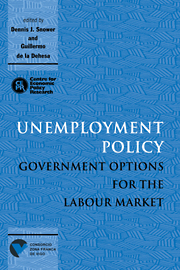Book contents
- Frontmatter
- Contents
- List of figures
- List of tables
- Preface
- Acknowledgements
- List of conference participants
- 1 Introduction
- PART ONE GENERAL POLICY ISSUES
- PART TWO DEMAND MANAGEMENT AND SUPPLY-SIDE POLICY
- PART THREE SUBSIDISING EMPLOYMENT AND TRAINING
- 6 The simple economics of benefit transfers
- Discussion
- Discussion
- 7 Wage subsidy programmes: alternative designs
- Discussion
- Discussion
- 8 Technological development, competition from low-wage economies and low-skilled unemployment
- Discussion
- 9 Macroeconomic and policy implications of shifts in the relative demand for skills
- Discussion
- 10 Would cutting payroll taxes on the unskilled have a significant impact on unemployment?
- Discussion
- 11 Preventing long-term unemployment: an economic analysis
- Discussion
- Discussion
- PART FOUR LABOUR MARKET REGULATIONS
- PART FIVE POLICY, JOB REALLOCATION AND THE UNEMPLOYMENT–PRODUCTIVITY RELATION
- PART SIX COMPARING UNEMPLOYMENT POLICIES
- Index
11 - Preventing long-term unemployment: an economic analysis
Published online by Cambridge University Press: 07 September 2010
- Frontmatter
- Contents
- List of figures
- List of tables
- Preface
- Acknowledgements
- List of conference participants
- 1 Introduction
- PART ONE GENERAL POLICY ISSUES
- PART TWO DEMAND MANAGEMENT AND SUPPLY-SIDE POLICY
- PART THREE SUBSIDISING EMPLOYMENT AND TRAINING
- 6 The simple economics of benefit transfers
- Discussion
- Discussion
- 7 Wage subsidy programmes: alternative designs
- Discussion
- Discussion
- 8 Technological development, competition from low-wage economies and low-skilled unemployment
- Discussion
- 9 Macroeconomic and policy implications of shifts in the relative demand for skills
- Discussion
- 10 Would cutting payroll taxes on the unskilled have a significant impact on unemployment?
- Discussion
- 11 Preventing long-term unemployment: an economic analysis
- Discussion
- Discussion
- PART FOUR LABOUR MARKET REGULATIONS
- PART FIVE POLICY, JOB REALLOCATION AND THE UNEMPLOYMENT–PRODUCTIVITY RELATION
- PART SIX COMPARING UNEMPLOYMENT POLICIES
- Index
Summary
Introduction and review
The EU has set the target of halving unemployment by the year 2000 (CEU, 1993). How can thus be done without increasing inflation? The strategy must be to reduce those kinds of unemployment which do little to restrain inflation. The most obvious such category is long-term unemployment.
Effects of long-term unemployment
Let us examine the evidence. In wage equations long-term unemployment is usually found to have a very small (or zero) effect in reducing wage pressure. The reasons for this are obvious: long-term unemployed people are not good fillers of vacancies. This can be seen from data on exit rates from unemployment: exit rates decline sharply as duration increases. Equally, aggregate time series show that, for a given level of unemployment, vacancies increase the higher the proportion of unemployed who are long-term unemployed.
If long-term unemployment is an optional extra, depending on social institutions, it is not surprising that there are striking differences in its prevalence across countries. As table 11.1 shows, in the 1980s the majority of countries had between 3 and 6 per cent of the labour force in short-term unemployment (of under a year). But there were huge differences in long-term unemployment. It was under 1 per cent in the USA, Japan, Canada and Sweden and over 8 per cent in Spain, Belgium and Ireland.
Clearly some short-term unemployment is necessary in any economy, to avoid the inflationary pressure which would develop in an over-tight labour market.
- Type
- Chapter
- Information
- Unemployment PolicyGovernment Options for the Labour Market, pp. 333 - 349Publisher: Cambridge University PressPrint publication year: 1997
- 15
- Cited by



